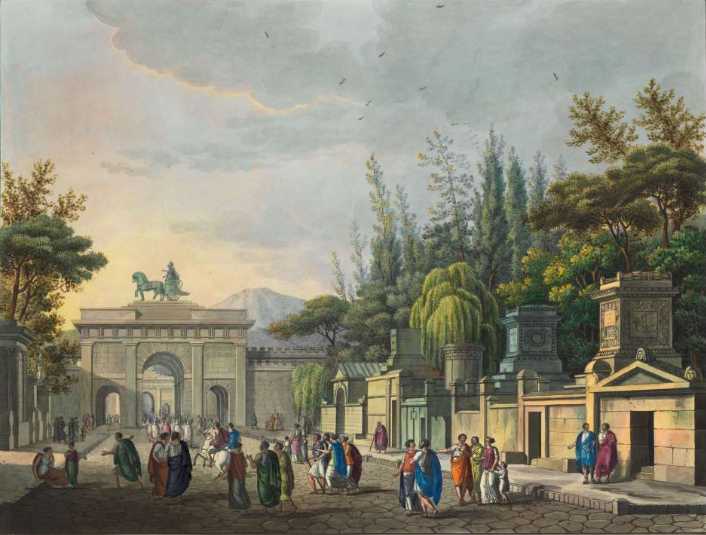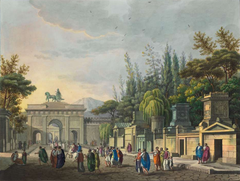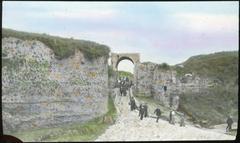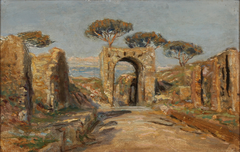
Porta Nola Pompeii Italy: Visiting Hours, Tickets, and Travel Guide
Date: 14/06/2025
Introduction: Unveiling Porta Nola’s Historical and Cultural Legacy
Porta Nola is one of Pompeii’s most evocative ancient gateways, situated at the northeastern corner of the city’s famed defensive walls. With origins in the Samnite era (4th–3rd century BCE) and subsequent Roman adaptations, Porta Nola stands today as a testament to military ingenuity, urban evolution, and the cultural rituals that defined ancient Pompeii. Its robust tuff and limestone structure, single archway, and adjacent necropolis offer a unique entry point into the city’s multifaceted past.
As part of the Pompeii Archaeological Park, Porta Nola is accessible with a general admission ticket, inviting visitors to explore both its architectural features and the rich funerary landscape just beyond its walls. This guide provides a comprehensive look at Porta Nola’s historical context, practical visitor information, travel tips, and the latest in ongoing preservation efforts. Whether you are an archaeology enthusiast or a first-time traveler, Porta Nola offers a quieter, contemplative journey through the layers of Pompeii’s history—aided by resources like the Pompeii Archaeological Park website and visual insights from pompeiiinpictures.com.
Contents
- Historical Background of Porta Nola
- Samnite Foundations and Defensive Role
- Roman Modifications and Civic Functions
- Necropolis and Funerary Context
- Visiting Porta Nola: Hours, Tickets, and Accessibility
- Travel Tips and Nearby Attractions
- Preservation and Research Initiatives
- Frequently Asked Questions (FAQ)
- Summary and Final Tips
- Sources and Further Reading
Historical Background of Porta Nola
Samnite Foundations and Defensive Role
Porta Nola, one of Pompeii’s seven principal gates, was initially constructed during the Samnite period as a key defensive structure. Its strategic placement along the ancient road to Nola, a significant neighboring settlement, underscores its importance for military defense and communication. The gate’s enduring stonework—crafted from tuff and limestone—reflects the advanced engineering of the era, designed to withstand both attacks and seismic events (madainproject.com).
Roman Modifications and Civic Functions
Following Pompeii’s transition to Roman control in the 2nd century BCE, Porta Nola evolved from a military checkpoint into a vital commercial and civic artery. The Romans expanded and reinforced the gate to accommodate increased traffic, facilitating the flow of goods and people between Pompeii and regional centers like Nola, Nuceria, and Acerrae. The gate’s architectural details, including its distinctive archway and flanking towers, blend Samnite and Roman construction techniques, as evidenced by the Oscan inscription commemorating Vibius Popidius, now housed in the British Museum.
Necropolis and Funerary Context
Outside Porta Nola lies one of Pompeii’s most significant necropoleis, where Roman law dictated that burials occur beyond city walls. This funerary landscape features a diversity of tombs, from monumental schola tombs and cinerary urn clusters to multi-generational family graves. Key discoveries, such as a life-size funerary relief of a married couple and tombs of priestesses, speak to the complex social, religious, and familial structures of Pompeii’s citizens (fieldsciences.org; allthatsinteresting.com).
Visiting Porta Nola: Hours, Tickets, and Accessibility
Visiting Hours
Porta Nola is included within the general opening hours of the Pompeii Archaeological Park:
- Standard Hours: 9:00 AM to 7:00 PM (last entry at 6:00 PM)
- Note: Hours may vary seasonally or for special events; always check the official website before your visit.
Tickets and Admission
- Standard Adult Ticket: Approx. €16–€22 (as of June 2025)
- Discounted Rates: Available for EU citizens aged 18-25
- Free Entry: For children under 18
- Where to Buy: Tickets must be purchased at the main entrances (Porta Marina, Piazza Anfiteatro, Piazza Esedra) or online. Porta Nola is not a ticketing point (timetravelturtle.com)
- Combined Tickets: Available, including entry to sites like Herculaneum, Oplontis, and Boscoreale (thegeographicalcure.com)
Accessibility
- Terrain: Uneven ancient paving stones and limited shade; challenging for those with mobility impairments
- Facilities: No restrooms, ticket booths, or food vendors near Porta Nola (nearest facilities at main entrances)
- Wheelchair Access: Some areas partially accessible; consult official accessibility resources in advance
Guided Tours and Audio Guides
- Guided Tours: Available through authorized operators and park services, offering in-depth insights into Porta Nola and the necropolis
- Audio Guides and Apps: Rent at main gates or download the Audiala app for interactive, self-guided experiences
Travel Tips and Nearby Attractions
- Best Times to Visit: Early mornings and late afternoons for cooler temperatures and fewer crowds
- Getting There: Pompeii is accessible via the Circumvesuviana train from Naples; Porta Nola is a 10–15 minute walk from the main entrances
- What to Bring: Comfortable walking shoes, water, sun protection, and a small bag (large bags must be checked at main entrances)
- Nearby Sites: Forum, Amphitheatre, House of the Faun, and other lesser-known gates like Porta Ercolano and Porta Vesuvio for comparisons in fortification styles (pompeiiinpictures.com)
- Photography: Best in soft morning or evening light; permitted throughout Pompeii except in restricted areas
Preservation and Research Initiatives
Recent years have seen significant conservation work at Porta Nola and its adjacent necropolis, including stabilization of masonry and documentation of tombs and inscriptions. Since 2017, the Porta Sarno Necropolis Project has advanced interdisciplinary research, combining archaeology, anthropology, and digital technologies to illuminate the lives and deaths of Pompeii’s inhabitants (fieldsciences.org; archaeological.org). These efforts ensure that the site remains accessible and informative for future generations.
Frequently Asked Questions (FAQ)
Q: What are Porta Nola’s visiting hours?
A: 9:00 AM to 7:00 PM, with last entry at 6:00 PM. Always check the official website for updates.
Q: Can I buy tickets at Porta Nola?
A: No. Tickets must be purchased at the main entrances or online.
Q: Is Porta Nola accessible for visitors with mobility issues?
A: Accessibility is limited due to uneven ancient paving. Check official resources or book guided tours for assistance.
Q: Are there restrooms or food facilities near Porta Nola?
A: No. Facilities are located near the main entrances.
Q: Is photography allowed at Porta Nola?
A: Yes, but please do not climb or touch the ancient structures.
Summary and Final Tips
Porta Nola is a remarkable relic of Pompeii’s layered history, blending Samnite and Roman architectural ingenuity with a funerary landscape that offers profound insights into ancient life and death. As one of the best-preserved gates, it provides a peaceful, less crowded alternative to the main entrances, ideal for those seeking a deeper, more reflective experience within the archaeological park.
To make the most of your visit:
- Plan ahead by purchasing tickets online and reviewing park maps.
- Allocate at least three hours to explore both Porta Nola and its necropolis.
- Download the Audiala app for enhanced interpretive content.
- Respect preservation guidelines and the cultural significance of the site.
For the latest news, special events, and excavation updates, consult the Pompeii Archaeological Park website and trusted travel platforms (pompeiiinpictures.com). Embrace the quieter corners of Pompeii through Porta Nola and discover the stories etched into its enduring stones.
Sources and Further Reading
- Visiting Porta Nola in Pompeii: Hours, Tickets, History, and Travel Tips, 2025, Pompeii Archaeological Park (http://pompeiisites.org/)
- Porta Nola in Pompeii: Visiting Hours, Tickets & Architectural Highlights of a Historic Roman Gate, 2025, Pompeiiinpictures.com (https://pompeiiinpictures.com/pompeiiinpictures/Gates/Gate%20Nola.htm)
- Porta Nola Pompeii: Visiting Hours, Tickets, and Historical Significance, 2025, Madain Project & Archaeological Institute (https://madainproject.com/city_gates_of_ancient_pompeii)
- Porta Nola Visiting Hours, Tickets, and Insider Tips for Exploring Pompeii’s Historic Gate, 2025, Time Travel Turtle (https://www.timetravelturtle.com/italy/visit-pompeii/)
- Pompeii Funerary Relief Statues and Necropolis Discoveries, 2024, All That’s Interesting (https://allthatsinteresting.com/pompeii-funerary-relief-statues)
- Pompeii Field School and Necropolis Project, 2025, Field Sciences (https://www.fieldsciences.org/program/2025-italy-pompeii/)
- Pompeii Funerary Project, 2025, Archaeological Institute of America (https://www.archaeological.org/fieldwork/2025-italy-pompeii-funerary-project-2/)

































































